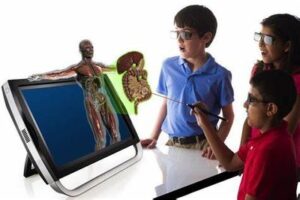Have you ever wondered how trending technology will change the way children learn? Read how technology has impacted and improved one of the most popular learning styles for young learners – experiential learning.

Technology’s Impact on Experiential Learning for Young Learners
What is experiential learning?
Experiential learning is a teaching approach that emphasizes learning through experience and reflection.
It involves hands-on activities, experimentation, and problem-solving. The National Association for the
Education of Young Children (NAEYC) boasts the importance of experiential learning as a part of young
learners’ education with, “learning through purposeful experiences has long been recognized as an
effective approach to teaching children. Pioneers of early education understood the importance of
children making sense of their world through observation and experimentation. Their keen understanding
of how young children learn continues to influence contemporary approaches to early childhood
education.
How does technology impact experiential learning?
Experiential learning, when combined with technology, can become even more powerful, providing
children with new and innovative ways to learn. Here are some ways that technology can enhance
children’s learning experience:
One of the most significant advantages of technology in experiential learning is that it provides young
learners with access to a wide range of resources and tools that can enhance their learning experience.
For instance, digital learning spaces. Using digital spaces to educate can be a great way to enhance
engagement by connecting young learners to experts in their field of study. In addition, digital spaces can
encourage collaboration by creating a forum to share ideas and experiences.
Another way technology is changing experiential learning is through online simulations and games. These
tools can be used to create a fun and engaging learning environment where students can learn through
trial and error. Games and simulations can also be tailored to the specific learning needs of individual
students, making the learning experience more personalized and effective.
Another significant advantage of technology in experiential learning in early education is that it can
provide children with a safe and controlled environment to practice their skills and apply theoretical
knowledge to real-world situations. For instance, virtual reality (VR) technology can simulate real-world
situations and provide children with a safe and controlled environment to practice their skills. According to
a publication by the National Library of Medicine on the use of technology, VR technology can be used in
various fields such as science, math, and language learning, to name a few, to provide children with an
immersive and interactive learning experience. Despite the numerous benefits, technology in experiential
learning in early education also presents its own set of challenges.
One of the biggest challenges is the need for teachers and parents to ensure that children are using
technology in an age-appropriate and safe manner. Moreover, it is essential to ensure that technology is
not a substitute for human interaction and that children have ample opportunities to interact with their
peers and teachers in a real-world setting.
In conclusion, technology has had a significant impact on experiential learning in early education,
transforming the way children learn and experience the world around them. By leveraging the power of
technology in experiential learning, children can develop critical thinking, problem-solving, and
collaboration skills that will prepare them for success in the future.